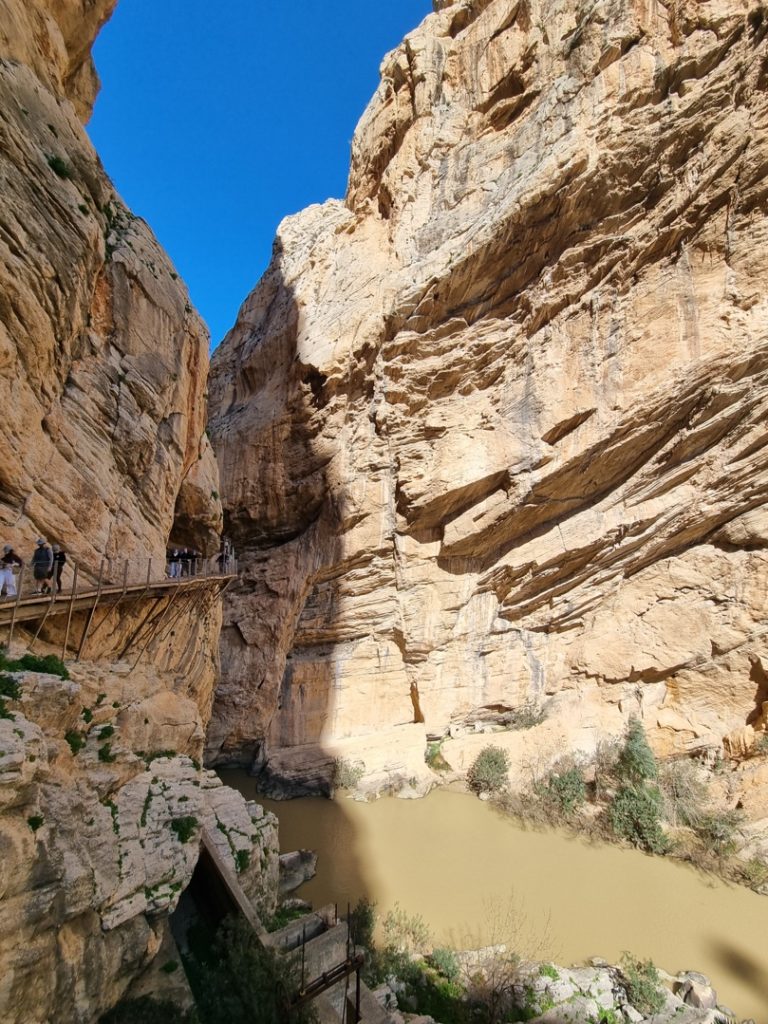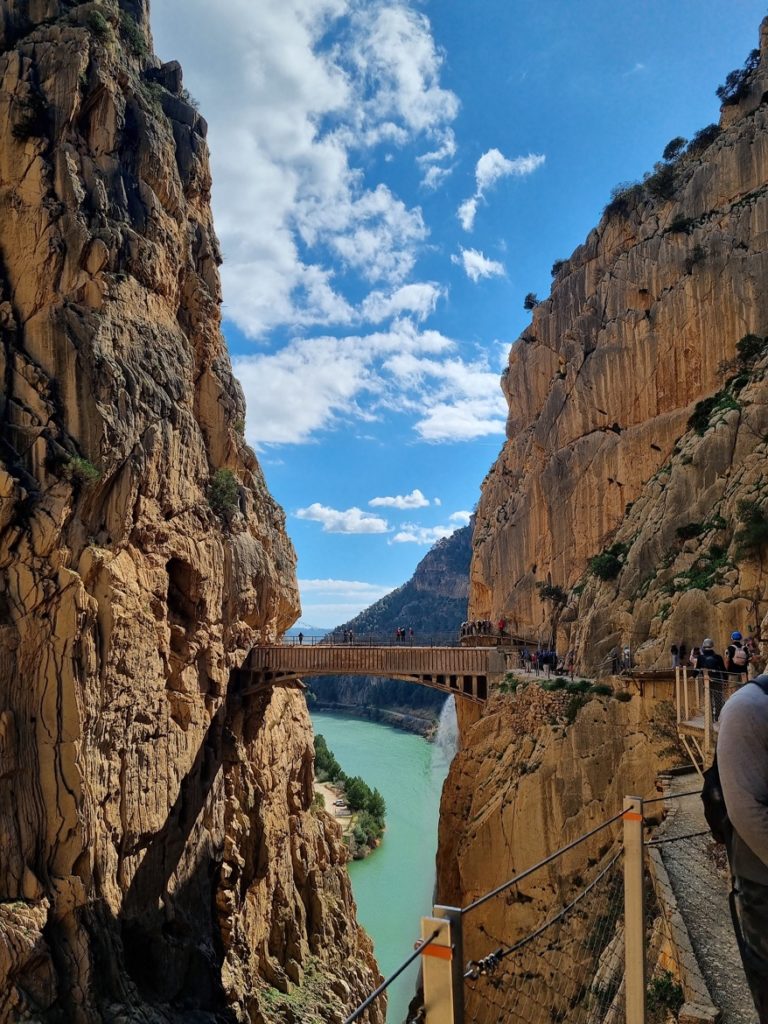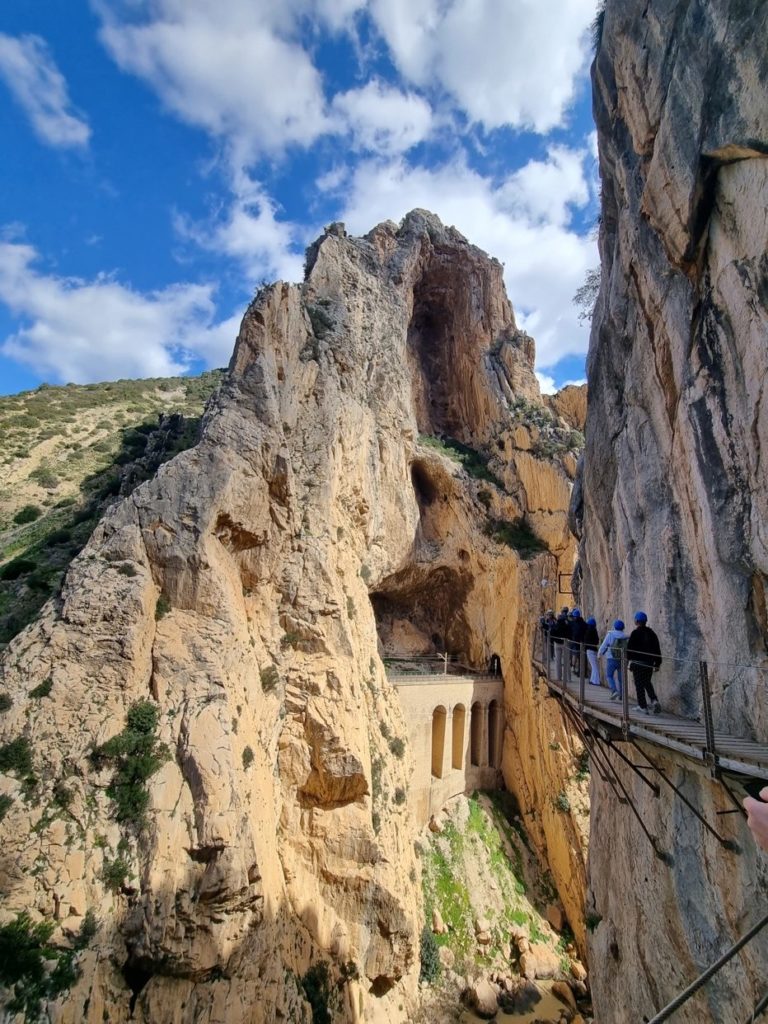“In every walk with nature, one receives far more than one seeks.” (John Muir)
This February, I had the unforgettable chance to explore the Caminito del Rey, the legendary ‘King’s Little Pathway’ perched high above the stunning El Chorro gorge near Málaga. Every step along this narrow, cliff-hugging trail felt like walking through history, a thrilling blend of breathtaking views, daring engineering, and centuries-old stories. I loved the mix of adventure and awe that this several-hours trail offers, making it a must-visit for anyone craving a walk on the wild side.
Caminito del Rey is a spectacular walkway pinned along the steep walls of a narrow gorge in Andalusia, southern Spain. Its origin dates back to the early 20th century, and it was originally built for industrial purposes, not tourism. Today, the Caminito del Rey is more than an adventure trail. Its origins are deeply rooted in early 20th century Spanish industrial development. In the late 19th and early 20th century, Spain was rapidly industrializing, and southern Spain, including the province of Málaga, began developing hydroelectric projects to meet growing electricity needs.
The Caminito del Rey was originally built to provide access for workers and engineers to maintain and inspect the channel that carried water between the Gaitanejo and El Chorro hydroelectric power stations, both owned by the Sociedad Hidroeléctrica del Chorro, a forerunner of what would become ENDESA, one of Spain’s major electricity companies nowadays.
It was constructed to facilitate transport of materials, maintenance of the channel, routine inspections and safe movement of workers between the two falls. Financed by the Sociedad Hidroeléctrica del Chorro, the project was a private industrial investment designed to enhance energy generation efficiency. The engineering project was quite ambitious for the time, as the trail clings to vertical rock faces, over 100 meters above the river. Construction of the original 1 meter wide path took place between 1901 and 1905. It was built mainly from concrete, wood and steel, affixed to the cliff using metal beams and brackets driven into the rock. At first it stretched on approximately 3 kilometers. Given the scale and danger, it was skilled and physically demanding work, dozens of local workers from nearby villages like Álora and Ardales, and engineers participated. Although detailed historical records are limited, it is very likely that there were also fatalities or serious injuries during construction, due to the extremely dangerous working conditions on sheer cliffs, the lack of modern safety equipment, manual tools and rudimentary scaffolding. At the time, occupational safety was minimal, and deaths in large infrastructure projects were sadly common.

Once the project was finished, it benefited from a royal inauguration. In 1921, King Alfonso XIII officially crossed the walkway for the inauguration of the Conde del Guadalhorce Dam. From that point on, it became known as El Caminito del Rey – The King’s Little Path.
The walkway served its original industrial purpose for several decades, especially between 1905 and the 1950s, supporting the operations of the hydroelectric facilities. However, as technology improved and maintenance needs changed, its use declined, but locals and thrill-seekers continued using it informally, despite its increasingly poor condition.
By the 1990s and early 2000s, the Caminito del Rey had deteriorated dangerously. Large sections had collapsed, and it became known as one of the world’s most dangerous walkways. Between 1999 and 2000, at least five people died attempting to cross it. The area has a history of both notorious accidents and fatalities, both work-related fatalities and later accidents involving thrill-seekers who attempted to cross the decaying structure. The most infamous incidents date back to 1999 and 2000, when five people died in separate accidents after slipping and falling from the deteriorated path. At the time, the walkway was crumbling, had no railings, and was often used by daredevils ignoring official warnings. As a result, the Spanish authorities closed it to the public in 2001. However, thrill-seekers kept sneaking in, climbing over barriers and risking their lives.
One tale involves a group of British tourists who misunderstood the nature of the trail back in its pre-renovation days. Expecting a casual scenic stroll based on a misleading travel brochure, they arrived in flip-flops and sun hats, only to find themselves clinging to rusty beams and dodging falling rocks. Local police had to escort them out, and one of the tourists later jokingly told a newspaper, ‘We thought it was like a promenade along a beach. Then we saw the mountain goats walking more confidently than we were.’
Also before the renovation, hikers would sometimes wear makeshift safety gear, like football helmets and climbing harnesses tied with rope bought from hardware stores. A viral YouTube video from around 2008 shows a man crawling across a broken plank while his friend shouts: ‘You’ll be fine!’…not exactly reassuring.

In 2011, a major restoration project was approved by the Andalusian Regional Government and the Diputación de Málaga(Provincial Council), which was the main driving force behind the project, in response to both its historical significance and growing international interest in the dangerous path. Its then-president, Elías Bendodo, was a vocal supporter of the restoration as a tool for rural tourism and economic development in the region. Junta de Andalucía (Andalusian Regional Government) provided co-financing and administrative support as it recognized the project’s potential for promoting Andalusia’s natural and cultural heritage. Municipalities of Ardales, Álora, and Antequera, the towns closest to the Caminito, supported the plan, seeing it as an opportunity to revitalize local economies. Architect Luis Machuca was the chief architect in charge of the new design and restoration, working under the Diputación. His work preserved the historical character while ensuring full modern safety compliance. As Elías Bendodo, then-president of the Diputación de Málaga, explained in 2014, ‘the restoration aimed to preserve a unique piece of industrial heritage and bring sustainable tourism to rural Andalusia’.
Restoration started in 2014 with a total cost of around 5.5 million EUR. The new path was built with wood and steel, just above the old concrete structure, maintaining historical visibility. It finally reopened to the public on March 28, 2015, when it was celebrated with large international media attention.

Now fully restored, the trail is heavily regulated, access is limited to a specific number of visitors per day, helmets are mandatory, tourists are supervised by trained staff and the trail paths, around 7.7 km long, are maintained regularly.
The project successfully increased rural and eco-tourism in the Málaga province, while preserving an iconic piece of industrial heritage. It also responded to rising international interest in the path, which had gained a cult reputation and succeeded to transform a lethal, decaying structure into a safe and educational experience. The restored path has since become a major success story, attracting hundreds of thousands of visitors each year, boosting the regional economy, and gaining multiple awards for sustainable tourism development.
The route showcases breathtaking views of the Desfiladero de los Gaitanes gorge, an important natural habitat. Visitors to the Caminito del Rey begin their journey by receiving trail equipment and helmets, followed by a short walk with a guide to the trail’s entrance. The 7 km long path is fully secured and safe, yet those with a fear of heights should be prepared for dizzying views as the walkway clings to vertical rock faces high above the gorge. Along the way, guides share fascinating insights into the history and geology of the area. Hikers can expect to traverse narrow passages between towering limestone cliffs, cross suspended bridges, and admire breathtaking natural scenery. One of the most striking features is the millions-of-years-old marine fossil visible in a rocky wall, as a reminder that this dramatic landscape was once submerged under ancient seas. The highlight of the journey is the slightly shaky suspended bridge at the end of the trail, offering both thrill and panoramic views. Just beyond, the landscape opens to reveal a tranquil lake with emerald waters, a perfect and serene reward after the exhilarating hike.

Caminito del Rey attracts now over 300,000 visitors each year. Since its reopening in 2015, the trail has welcomed nearly 3 million visitors, producing an estimated 400 million EUR in total economic activity across nearby communities. Only in the most recent year alone, it contributed approximately 64 million EUR, bringing significant annual benefits to local businesses and services. (Source: elpais.com)
Generally, the best time to visit Caminito del Rey is during spring (March to May) and autumn (September to early November), when temperatures are mild, skies are clear, and the trail is less crowded.
Caminito del Rey is not alone in offering heart-stopping thrills and spectacular scenery. Around the globe, similar cliff-side trails and pathways beckon the daring and curious. Half Dome Trail in the Yosemite National Park, USA is known for its steep granite dome and iconic cable-assisted climb. Like the Caminito del Rey, it combines natural wonder with a sense of adventure and accomplishment. Trolltunga Trail in Norway, a long and physically demanding hike above the fjords, extends as a jutting rock ledge offering jaw-dropping vistas. Its raw beauty and photographic appeal make it a bucket-list destination for many hikers. Via Ferrata Routes in the Italian Alps provides a thrilling blend of hiking and climbing. Like Caminito del Rey, Via Ferrata paths often trace historical or industrial sites, repurposed for recreational use. Gorge of the Verdon in France, known as the ‘Grand Canyon of Europe’, hosts several cliff-side trails along rugged limestone cliffs and turquoise waters, delivering a mix of natural beauty and adventure, akin to that of the Caminito del Rey. Mount Huashan Plank Walk in China, often dubbed the world’s most dangerous hike, consists of narrow wooden planks bolted to sheer cliffs. Hikers must wear harnesses and proceed with caution on this vertigo-inducing path, making it a unique thrill-seeker’s challenge. Kalalau Trail in Hawaii, USA, running along Hawaii’s Nā Pali Coast, offers lush landscapes, cliff edges and cascading waterfalls, beautifully combining tropical beauty with sections of rugged, exposed terrain, making it a popular trail for adventurous hikers.

But what sets Caminito del Rey apart is its rich history and the way it was meticulously restored to preserve its authentic character while ensuring modern safety standards. This blend of cultural heritage and natural splendor creates a unique experience that resonates deeply with visitors. Nowadays, in the digital era, the hike is becoming ever more popular. The hashtag #caminitodelrey has been used in more than 100,000 Instagram posts already. This figure reflects a steady usage rate of about 1 post per hour, indicating a consistent level of engagement from visitors and enthusiasts sharing their experiences on the trail. (Source: best-hashtag.com) The hashtags collectively contribute to a vibrant online community, sharing a wealth of photos, videos, and personal stories that showcase the trail’s allure and the experiences of those who venture along its path, proof that this hike fully deserves attention.
Walking along the Caminito del Rey’s narrow edges, surrounded by soaring cliffs and endless skies, I felt connected not only to Spain’s rich history but to a global community of adventurers drawn to nature’s most thrilling paths. Caminito del Rey is more than a walkway; it is an invitation to live boldly, embrace the beauty around us, and cherish every step of the journey.
alexandra.paucescu@europe-diplomatic.eu

